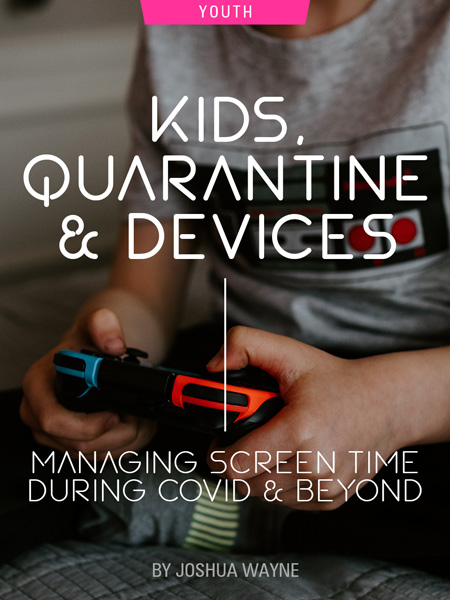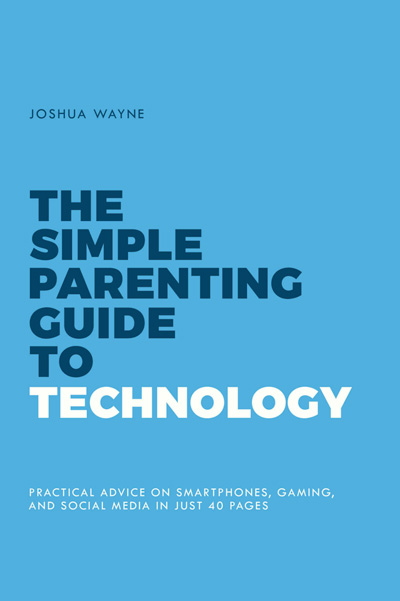
In a time where parents find themselves wearing many hats, it’s easy to reach for a screen. Here are tips from an expert on managing kids & technology.
—
The Hard Work of Managing Kids’ Devices During a Quarantine (and in General)
One afternoon, about a year and a half ago, I was looking at my bookshelf and noticed 6 parenting books I had purchased within the previous 12 months, but never read. Out of curiosity I picked each one up to look up the page count. The average was 232.
Now I’ve been working as a counselor with teens and their parents for nearly 25 years, so I have an intrinsic motivation to stay up-to-date on fresh ideas, but I hadn’t actually even opened any of the books since Amazon dropped them on my doorstep — until this particular afternoon when my curiosity got hold of me.
Why?
Simply put: time.
Having a 6 year old at home, a wife I’m committed to staying married to and a busy career — who has time to sit down and read all these 200+ page books… especially when I have to sort through the 80% filled with theories, anecdotes and research just to get to the 20% of truly helpful information?
So it got me thinking…
What if I wrote a book — or a series of books — that cut out the 80% of stuff that keeps me procrastinating in the first place, and just focus on the 20% of practical takeaways? What if I wrote some books for parents who find themselves thinking (as I know I do) “Please, just tell me what to do!”?
the idea behind The Simple Parenting Guides was born.
I have been speaking and writing about kids and tech for the past couple years so it seemed like the obvious place to begin the series. I began working on it about a year ago, and The Simple Parenting Guide to Technology: Practical Advice on Smartphones, Gaming and Social Media in Just 40 Pages was released on May 17, 2020.
Now, If only my book release story were as straightforward and linear as my process for writing it. Instead, I find myself having to pivot and discuss the fact that just 2 months before the book was scheduled to make its debut, the world came to a screeching halt as the result of a global pandemic. Most of us were forced to hole up in our homes and had to really scramble to figure out what to do with the kids. While many people have enjoyed the forced slow-down (at least for a bit), it has also been incredibly stressful for a lot of us. Many lost their jobs, and those lucky enough to still have them have had to figure out how to keep their kids productively engaged while jumping from Zoom call to Zoom call.
Sure, our best effort at homeschooling (which in my case isn’t saying much) can eat up about 45 minutes of the day (I have even more massive respect for teachers now), and if lucky, we might stretch out a family walk to eat up another hour or so… but what then? Those iPhones, cracked screens and all, are just sitting there staring at us, as if whispering, “Yes. Come pick me up. I can help.”
Our kids certainly won’t resist such an opportunity. Should we?
In the pressure cooker of being home full-time with school age children while still trying to maintain some sense of normalcy, this becomes a very challenging question to answer, and many parents — even with the best of intentions, have found their normal restrictions going out the window.
Had my book just become irrelevant, or more relevant than ever?
Admittedly, I asked myself that question and contemplated postponing the release, but through the counsel of friends and family (and several glasses of wine with my wife — don’t judge), I decided to proceed as planned. I’ve since become convinced that the timing for this message is now more important than ever in a time when kid’s device use can easily go off the rails altogether.
So what should our attitude towards our kid’s screen time be during these strangest of times?
First and foremost, we have to remember that the real priority right now is making sure everybody gets through this in one piece…
Mentally and physically. In an era where adolescent depression and anxiety rates were already spiking, and when in 2014 suicide became the second leading cause of death amongst teenagers — the last thing we need to do is create unnecessary stress for our kids, and for our family in general. Staying connected to our kids in a healthy, positive way is more important than how much school work they get done and how much time they spend looking at their phone.
So when it comes to device use right now, my advice is to take a deep breath and relax about it, with these few caveats:
Make Sure Devices Don’t Overtake Your Relationship
As I just mentioned, staying emotionally connected with our children is massively important right now. Whether they realize it or not, they need connection with you right now. They need you in their world (even if you barely understand it at times) so cook together, listen to music, play board games, and geek out on some Netflix (OK, technically screen time, but I’ll take that any day over more Fortnite). Whatever you can do to share time and space with them in a low-pressure, fun way — DO THAT.
Make Sure They’re Getting Fresh Air (And Sweating, If Possible)
I get they can’t be out running around with their friends or playing sports as they do under normal circumstances on playgrounds and sports fields with teams — but kids still need to move around. Physical activity stimulates and regulates the brain like nothing else does. Try to make this a cornerstone of your time together by throwing the ball around, going for hikes, or creating some body weight exercise routines in your backyard together.
Make Sure Devices Go To Bed At Night Too
If you can do absolutely nothing else, make sure there is a clear time that devices get shut down at night — and then stick to it. Kids need to go to bed and they need clear boundaries. Many of them, if allowed to, will become nocturnal animals otherwise. This is fine here and there when they have sleepovers and such, but it’s not good as a matter of habit for their physical, mental and social wellbeing. Pick a time at night that’s reasonable and shut everything down. If you have to, gather up all the devices and store them in your room. And if they claim they need their phone as an alarm clock in the morning — well, right now they don’t — but in normal times, an alarm clock will cost you about 10 bucks. It worked when you and I were kids, right?
So in summary, YES, absolutely lighten up when it comes to their device use right now, but NO, don’t let go of the reins altogether. Unprecedented times call for some flexibility.
Under normal circumstances, the average American teen spends a staggering 7.5 hours a day in front of a screen and that doesn’t even include time spent on school work. If unchecked during this time, that number can easily double. It’s hard to argue this is healthy using any common definition of the word, so lovingly stay on top of them and insist on these basic rules. They may not always like the limits you set, but they need them to grow into healthy digital citizens.
Perhaps they’ll even thank you… someday.
And another thing, the reality is that we could all use a little less screen time — especially when navigating stressful times. Step away from your own screens and lead by example. You might just enjoy it!
You may also enjoy reading Digital Minimalism: How to Manage Technology to Reclaim Your Life by Vinayak Garg.
